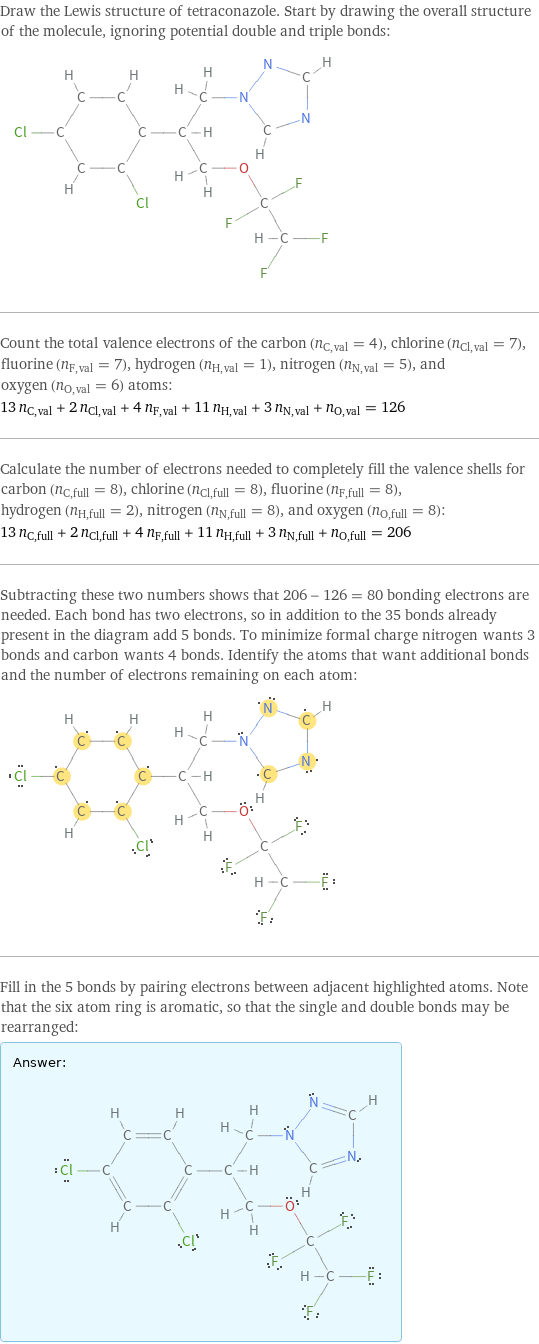Input interpretation

tetraconazole
Chemical names and formulas
![formula | C_13H_11Cl_2F_4N_3O name | tetraconazole IUPAC name | 1-[2-(2, 4-dichlorophenyl)-3-(1, 1, 2, 2-tetrafluoroethoxy)propyl]-1, 2, 4-triazole alternate names | domark | eminent mass fractions | C (carbon) 42% | Cl (chlorine) 19.1% | F (fluorine) 20.4% | H (hydrogen) 2.98% | N (nitrogen) 11.3% | O (oxygen) 4.3%](../image_source/f0f4d8a6ff85a4cd4f96e55f6e11b3de.png)
formula | C_13H_11Cl_2F_4N_3O name | tetraconazole IUPAC name | 1-[2-(2, 4-dichlorophenyl)-3-(1, 1, 2, 2-tetrafluoroethoxy)propyl]-1, 2, 4-triazole alternate names | domark | eminent mass fractions | C (carbon) 42% | Cl (chlorine) 19.1% | F (fluorine) 20.4% | H (hydrogen) 2.98% | N (nitrogen) 11.3% | O (oxygen) 4.3%
Lewis structure

Draw the Lewis structure of tetraconazole. Start by drawing the overall structure of the molecule, ignoring potential double and triple bonds: Count the total valence electrons of the carbon (n_C, val = 4), chlorine (n_Cl, val = 7), fluorine (n_F, val = 7), hydrogen (n_H, val = 1), nitrogen (n_N, val = 5), and oxygen (n_O, val = 6) atoms: 13 n_C, val + 2 n_Cl, val + 4 n_F, val + 11 n_H, val + 3 n_N, val + n_O, val = 126 Calculate the number of electrons needed to completely fill the valence shells for carbon (n_C, full = 8), chlorine (n_Cl, full = 8), fluorine (n_F, full = 8), hydrogen (n_H, full = 2), nitrogen (n_N, full = 8), and oxygen (n_O, full = 8): 13 n_C, full + 2 n_Cl, full + 4 n_F, full + 11 n_H, full + 3 n_N, full + n_O, full = 206 Subtracting these two numbers shows that 206 - 126 = 80 bonding electrons are needed. Each bond has two electrons, so in addition to the 35 bonds already present in the diagram add 5 bonds. To minimize formal charge nitrogen wants 3 bonds and carbon wants 4 bonds. Identify the atoms that want additional bonds and the number of electrons remaining on each atom: Fill in the 5 bonds by pairing electrons between adjacent highlighted atoms. Note that the six atom ring is aromatic, so that the single and double bonds may be rearranged: Answer: | |
3D structure

3D structure
Basic properties

molar mass | 372.1 g/mol phase | liquid (at STP) melting point | 6 °C boiling point | 438 °C density | 1.5 g/cm^3 solubility in water | insoluble
Units

Liquid properties (at STP)

density | 1.5 g/cm^3 vapor pressure | 6.9×10^-8 mmHg (at 25 °C)
Units

Thermodynamic properties

molar heat of vaporization | 69.52 kJ/mol specific heat of vaporization | 0.1868 kJ/g (at STP)
Chemical identifiers

CAS number | 112281-77-3 PubChem CID number | 80277 SMILES identifier | C1=CC(=C(C=C1Cl)Cl)C(CN2C=NC=N2)COC(C(F)F)(F)F InChI identifier | InChI=1/C13H11Cl2F4N3O/c14-9-1-2-10(11(15)3-9)8(4-22-7-20-6-21-22)5-23-13(18, 19)12(16)17/h1-3, 6-8, 12H, 4-5H2 EU number | 407-760-6
NFPA label

NFPA label

NFPA health rating | 1 NFPA fire rating | 0 NFPA reactivity rating | 0
Safety properties

flash point | 219 °C